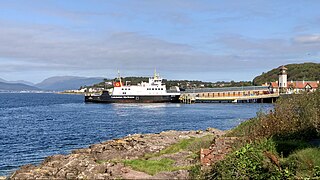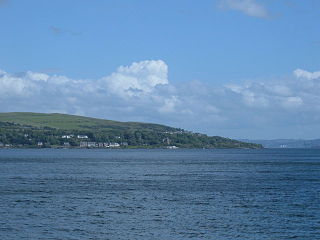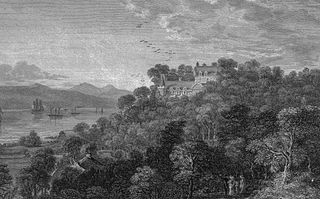
Castle Wemyss was a large mansion in Wemyss Bay, Scotland. It stood on the southern shore of the Firth of Clyde at Wemyss Point, where the firth turns southwards.

Castle Wemyss was a large mansion in Wemyss Bay, Scotland. It stood on the southern shore of the Firth of Clyde at Wemyss Point, where the firth turns southwards.
It was built around 1850 for Charles Wilsone Brown, a property developer who had plans to develop the land around Wemyss Bay, and who by 1855 had increased the number of villas from four to thirty-six. These villas earned the nickname 'Little Glasgow' because they were let to wealthy Glasgow merchants. [1]
Wilsone Brown sold the mansion to Sir John Burns (later Baron Inverclyde) in 1860. Burns commissioned the architect Robert William Billings to remodel the house in the Scottish baronial style, expanding the original structure by adding a new floor, new wings and a clock tower to the south-east corner.
Castle Wemyss became a fashionable destination for many well-known visitors, including Lord Shaftesbury, Anthony Trollope, General Sherman, Henry Morton Stanley, Peter II of Yugoslavia, Emperor Haile Selassie and members of the British royal family.
It is reputed that Trollope wrote part of Barchester Towers whilst at Wemyss Bay, and that 'Portray Castle' in The Eustace Diamonds was based on Castle Wemyss. [2] Whether this is true or not, Trollope places Portray in a similar geographical location, with a description which is very like that of the castle and its grounds. Trollope did however include the real Castle Wemyss in his travelogue How the 'Mastiffs' Went to Iceland , a record of a trip from the Clyde to Iceland in June and July 1878. [3]
The house remained in the Burns family until the death of Alan, 4th Baron Inverclyde, in 1957. None of his family was able to afford the cost of maintaining such a large property and it was sold to a developer. Inverkip Power Station was built on the northern part of the estate grounds.

Greenfield legislation meant that whilst much of the larger estate was developed as Wemyss Bay grew in the 1960s and 1970s, the house itself was left untouched. Gradually falling into decay (and subsequently de-roofed to avoid payment of housing rates) it was not until 1984 that it was finally demolished.
In the 1990s the grounds themselves were finally redeveloped, and all that now remains of the house is a broken flight of stone steps and a flagpole. An established monkey puzzle tree marking the entrance to the drive had to be removed for safety reasons. However, the locally formed Woodlands Trust have started to reclaim the Victorian fernery from the rhododendrons. Formal paths have now been established in the woods which are immediately adjacent to the site of the former castle.

Inverclyde is one of 32 council areas used for local government in Scotland. Together with the East Renfrewshire and Renfrewshire council areas, Inverclyde forms part of the historic county of Renfrewshire, which currently exists as a registration county and lieutenancy area. Inverclyde is located in the west central Lowlands. It borders the North Ayrshire and Renfrewshire council areas, and is otherwise surrounded by the Firth of Clyde.

The Firth of Clyde is the estuary of the River Clyde, on the west coast of Scotland. The Firth has some of the deepest coastal waters of the British Isles. The Firth is sheltered from the Atlantic Ocean by the Kintyre peninsula. The Firth lies between Argyll and Bute in the west and Inverclyde, North Ayrshire and South Ayrshire in the east. The Kilbrannan Sound is a large arm of the Firth, separating the Kintyre Peninsula from the Isle of Arran. The Kyles of Bute separates the Isle of Bute from the Cowal peninsula.

Dunoon is the main town on the Cowal peninsula in the south of Argyll and Bute, Scotland. It is located on the western shore of the upper Firth of Clyde, to the south of the Holy Loch and to the north of Innellan. As well as forming part of the council area of Argyll and Bute, Dunoon also has its own community council. Dunoon was a burgh until 1976.

Skelmorlie is a village in North Ayrshire in the southwest of Scotland. Although it is the northernmost settlement in the council area of North Ayrshire, it is contiguous with Wemyss Bay, which is in Inverclyde. The dividing line is the Kelly Burn, which flows into the Firth of Clyde just south of the Rothesay ferry terminal. Despite their proximity, the two villages have historically been divided, Skelmorlie in Ayrshire and Wemyss Bay in Renfrewshire.

Greenock is a town in Inverclyde, Scotland, located in the west central Lowlands of Scotland. The town is currently the administrative centre of Inverclyde Council. It is a former burgh within the historic county of Renfrewshire, and forms part of a contiguous urban area with Gourock to the west and Port Glasgow to the east.

Wemyss Bay is a village on the coast of the Firth of Clyde in Inverclyde in the west central Lowlands of Scotland. It is in the traditional county of Renfrewshire. It is adjacent to Skelmorlie, North Ayrshire. The town and villages have always been in separate counties, divided by the Kelly Burn.

Inverclyde is a parliamentary constituency of the House of Commons of the Parliament of the United Kingdom. It replaced Greenock and Inverclyde and the Port Glasgow and Kilmacolm areas from West Renfrewshire for the 2005 general election.

The Inverclyde Line is a railway line running from Glasgow Central station through Paisley and a series of stations to the south of the River Clyde and the Firth of Clyde, terminating at Gourock and Wemyss Bay, where it connects to Caledonian MacBrayne ferry services. The line has been in operation since the 1840s between Glasgow and Greenock and was the first passenger service to follow the River Clyde to the coast. The line was electrified in 1967.
Wemyss can refer to:

Newark Castle is a well-preserved castle sited on the south shore of the estuary of the River Clyde in Port Glasgow, Inverclyde, Scotland, where the firth gradually narrows from the Firth of Clyde and navigation upriver is made difficult by shifting sandbanks. For centuries this location was used to offload seagoing ships, and led to the growth of Port Glasgow close to the castle on either side and to the south. When dredging techniques made the Clyde navigable as far as Glasgow the port became a shipbuilding centre, and the castle was surrounded by shipyards. Ferguson Shipbuilders, the last shipyard on the lower Clyde, stands close to the west of the castle, but the shipyards to the east were removed around the 1980s and new landscaped areas formed to the east of Newark Castle, opening up scenic views of the castle and across the Clyde from a new bypass road.

Greenock West railway station is a station in Greenock, Scotland, located on the Inverclyde Line which runs from Gourock to Glasgow Central. The route is currently operated by ScotRail under the auspices of Strathclyde Partnership for Transport. Each service to and from Glasgow on the Inverclyde Line stops at this station.

Renfrewshire or the County of Renfrew is a historic county, registration county and lieutenancy area in the west central Lowlands of Scotland. The lieutenancy area covers the three modern council areas of Inverclyde, Renfrewshire and East Renfrewshire, and this area is occasionally termed Greater Renfrewshire to distinguish it from the modern council area called Renfrewshire. The historic county additionally included territory on the south-western edge of Glasgow which was gradually transferred to the administrative area of the city as it grew.

Cove is a village on the south-west coast of the Rosneath Peninsula, on Loch Long, in Argyll and Bute, western Scotland.
The Glasgow, Paisley and Greenock Railway (GP&GR) was an early Scottish railway, opened in 1841, providing train services between Greenock and Glasgow. At the time the River Clyde was not accessible to sea-going ships, and the intention was to compete with river boats that brought goods to and from the city. In fact passenger traffic proved surprisingly buoyant, and connecting steamer services to island resorts in the Firth of Clyde provided a very great source of business.
The Greenock and Wemyss Bay Railway was a railway owned by the Caledonian Railway, providing services between Greenock and Wemyss Bay.
Woodhall is a housing scheme in the lower east end of Port Glasgow, Inverclyde in Scotland. It stands on land once occupied by Woodhall mansion and estate. The mansion stood where St Martin's church now stands on Mansion Avenue. Woodhall is on a north facing slope, overlooking the River Clyde and is bounded on the north by the River Clyde, on the south by Parkhill Avenue, on the west by Port Glasgow cemetery and on the east by what is now the Castlebank housing estate which is on the site of the former Broadfield Hospital.

Skelmorlie Castle stands on the eastern shore of the Firth of Clyde, Scotland, at the north-western corner of the county of Ayrshire. The structure dates from 1502, and was formerly the seat and stronghold of the Montgomery Clan. The modern village of Skelmorlie lies to the north of the castle.

John Burns, 1st Baron Inverclyde, was a Scottish ship owner.

James Cleland Burns, 3rd Baron Inverclyde, was the second son of John Burns, the first Lord Inverclyde, and grandson of Sir George Burns, 1st Baronet, a founder of the Cunard Line. James Burns succeeded to the title of Baron Inverclyde on the death of his elder brother, George Burns, in 1905.

Meigle or Meagle is a hamlet on the Meigle Burn in North Ayrshire, Parish of Largs, Scotland. The settlement lies close to the road to Greenock and is named after the bay where the Skelmorlie Burn flows into the Firth of Clyde. Meigle once stood on the old toll road from Largs to Greenock. It lies 41 m (135 ft) above sea level. Skelmorlie Castle and glen lie nearby. The Meigle Burn has its confluence with the Skelmorlie Burns to the east of Skelmorlie Bridge. The modern spelling 'Meigle' will be used for consistency. There is also a village called Meigle in Perth & Kinross.